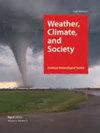确定日常天气信息使用模式及其人口统计学决定因素
IF 1.9
4区 地球科学
Q3 ENVIRONMENTAL STUDIES
引用次数: 0
摘要
天气和自然灾害的社会科学研究已经深入研究了个人在应对灾害时使用的信息来源。这项研究主要侧重于孤立的信息来源以及与恶劣天气有关的信息来源。因此,很少有研究调查个人如何在日常时间使用信息获取策略。本文通过检查常规天气信息源的使用模式来解决这一限制。使用三个独特的调查数据集和潜在类分析,我们发现天气信息源的使用可以通过有限数量的连贯类来总结。重要的是,我们的结果表明,天气信息类型或类别在数据集和样本之间通常是一致的。我们还发现,人口统计学决定因素,尤其是年龄,有助于解释阶级成员;年龄较大的受访者更有可能属于对基于技术的信息来源依赖程度较低的阶层。收入和教育程度也与更复杂或更全面的信息使用策略有关。结果表明,在以前的研究中,单一来源信息使用的流行观点可能不足以理解个人如何在常规和极端环境中获取信息。本文章由计算机程序翻译,如有差异,请以英文原文为准。
Determining Patterns of Routine Weather Information Usage and Their Demographic Determinants
Social science studies of weather and natural hazards have examined in depth the sources of information individuals use in response to a disaster. This research has primarily focused on information sources in isolation and as they relate to severe weather. Thus, less research has examined how individuals use information acquisition strategies during routine times. This paper addresses this limitation by examining patterns of routine weather information source usage. Using three unique survey datasets and Latent Class Analysis, we find that weather information source usage can be summarized by a limited number of coherent classes. Importantly, our results suggest weather information types, or classes, are generally consistent across datasets and samples. We also find demographic determinants, particularly age, help explain class membership; older respondents were more likely to belong to classes less reliant on technology-based information sources. Income and education also were related to more complex or comprehensive information use strategies. Results suggest the prevalent view of single-source information usage in previous research may not be adequate for understanding how individuals access information, in both routine and extreme contexts.
求助全文
通过发布文献求助,成功后即可免费获取论文全文。
去求助
来源期刊

Weather Climate and Society
METEOROLOGY & ATMOSPHERIC SCIENCES-
CiteScore
3.40
自引率
13.60%
发文量
95
审稿时长
>12 weeks
期刊介绍:
Weather, Climate, and Society (WCAS) publishes research that encompasses economics, policy analysis, political science, history, and institutional, social, and behavioral scholarship relating to weather and climate, including climate change. Contributions must include original social science research, evidence-based analysis, and relevance to the interactions of weather and climate with society.
 求助内容:
求助内容: 应助结果提醒方式:
应助结果提醒方式:


